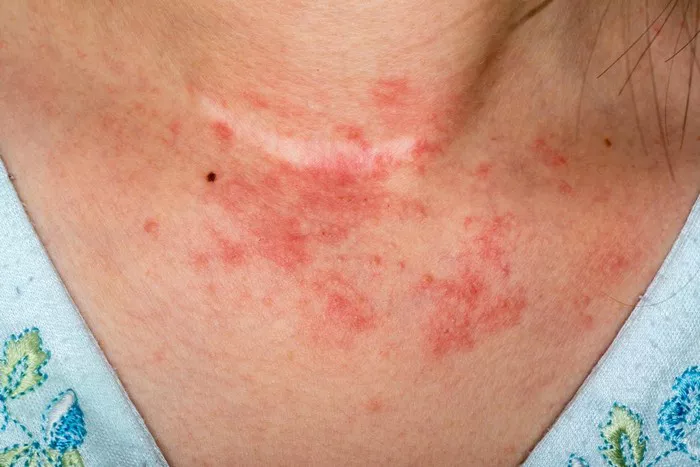Psoriatic arthritis (PsA) is a chronic autoimmune disease that combines the symptoms of arthritis with those of psoriasis. This complex condition affects various parts of the body, primarily targeting the joints and skin. One of the most common and notable manifestations of PsA is the psoriatic rash, which raises the question: does this rash itch?
Understanding Psoriatic Arthritis
Psoriatic arthritis is an inflammatory disease that causes joint pain, swelling, and stiffness. It belongs to a group of diseases known as spondyloarthropathies and is closely related to psoriasis, a skin condition that causes red, scaly patches. Approximately 30% of people with psoriasis will develop PsA. While the exact cause of PsA is unknown, it is believed to result from a combination of genetic, immunological, and environmental factors.
The Nature of Psoriatic Rash
Psoriasis manifests in various forms, with the most common being plaque psoriasis, which features raised, red patches covered with a silvery-white buildup of dead skin cells or scales. These patches are often found on the scalp, elbows, knees, and lower back. Other types of psoriasis include guttate, inverse, pustular, and erythrodermic psoriasis, each presenting unique symptoms and distribution patterns on the body.
Itching and Psoriasis
One of the hallmark symptoms of psoriasis is itching. Studies indicate that up to 90% of people with psoriasis experience itching, which can range from mild to severe. The itching associated with psoriasis is often due to inflammation and increased turnover of skin cells, which can irritate nerve endings in the skin. Additionally, the dry, scaly nature of psoriatic plaques can contribute to an itchy sensation.
Itching in Psoriatic Arthritis
In PsA, the psoriatic rash can indeed itch, mirroring the symptoms experienced in psoriasis without arthritis. However, the intensity and frequency of itching can vary widely among individuals. Several factors can influence this variability, including the type and severity of psoriasis, the specific areas of the body affected, and the individual’s overall health and stress levels.
Factors Contributing to Itching in PsA
Inflammation: Chronic inflammation is a core feature of PsA. The immune system’s overactivity leads to the rapid turnover of skin cells and the formation of psoriatic plaques, which can itch intensely.
1. Dry Skin: Psoriatic plaques are often dry and scaly, contributing to the sensation of itching. The lack of moisture can exacerbate this dryness, leading to more pronounced itching.
2. Nerve Sensitivity: The skin affected by psoriatic plaques can become more sensitive due to inflammation and the buildup of scales, leading to increased nerve sensitivity and itching.
3. External Factors: Weather conditions, clothing, stress, and other environmental factors can influence the severity of itching in individuals with PsA. For example, cold, dry weather can worsen skin dryness and itching, while stress can trigger or exacerbate psoriasis symptoms.
SEE ALSO: The 6 Best Topical Steroids for Psoriasis
Managing Itching in Psoriatic Arthritis
Effective management of itching in PsA involves a combination of treatments aimed at reducing inflammation, moisturizing the skin, and addressing specific triggers. Here are some strategies that can help alleviate itching:
Medical Treatments
1. Topical Treatments: Topical corticosteroids, vitamin D analogs, and calcineurin inhibitors can reduce inflammation and itching in psoriatic plaques. Moisturizing creams and ointments are also essential to keep the skin hydrated.
2. Systemic Treatments: For moderate to severe PsA, systemic treatments such as methotrexate, cyclosporine, and biologics (e.g., TNF inhibitors, IL-17 inhibitors) can help control both joint and skin symptoms, including itching.
3. Phototherapy: Ultraviolet (UV) light therapy can be effective in reducing psoriatic skin lesions and associated itching. It works by slowing down the rapid growth of skin cells and reducing inflammation.
Lifestyle Modifications
1. Skin Care: Regularly moisturizing the skin with emollients can help reduce dryness and itching. Gentle skin care routines, including using mild, fragrance-free soaps and avoiding hot water, can prevent further irritation.
2. Stress Management: Stress can exacerbate PsA symptoms, including itching. Techniques such as mindfulness, meditation, and exercise can help manage stress levels.
3. Avoiding Triggers: Identifying and avoiding triggers that worsen itching, such as certain fabrics, harsh soaps, and extreme temperatures, can help manage symptoms.
The Psychological Impact of Itching
The itching associated with PsA can have a significant psychological impact. Chronic itching can lead to sleep disturbances, anxiety, depression, and reduced quality of life. It is essential for healthcare providers to address the psychological aspects of itching and provide support and resources to help patients cope with the emotional burden of the disease.
Research and Future Directions
Ongoing research into the pathophysiology of PsA and psoriasis aims to uncover new therapeutic targets and improve existing treatments. Advances in understanding the genetic and immunological mechanisms underlying PsA may lead to more effective and personalized treatment approaches, ultimately reducing symptoms such as itching.
Conclusion
Psoriatic arthritis is a multifaceted disease that presents with both joint and skin symptoms. The psoriatic rash associated with PsA can indeed itch, significantly impacting the quality of life for those affected. Understanding the factors that contribute to itching and employing a comprehensive approach to treatment and management can help alleviate this bothersome symptom. As research continues to advance, new therapies may offer even greater relief for individuals living with psoriatic arthritis.
Related Topics:


























